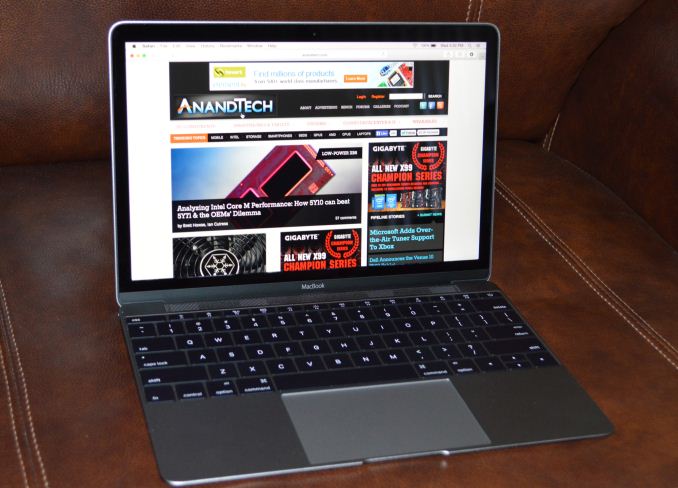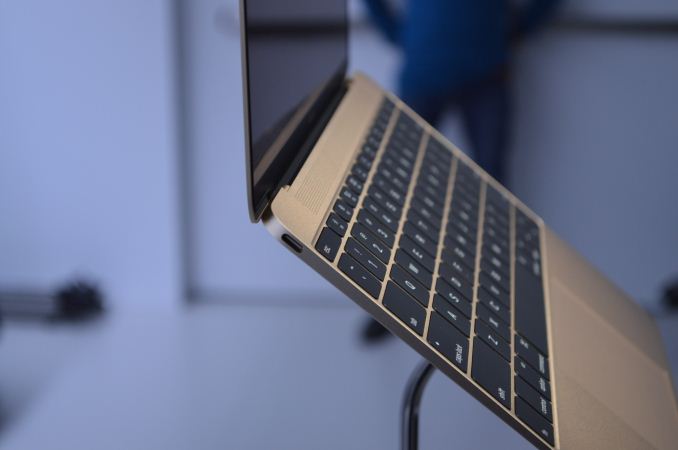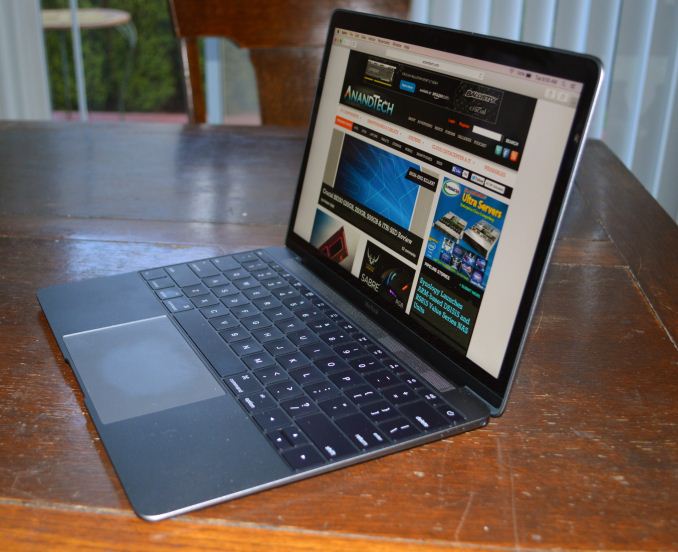The 2015 MacBook Review
by Ryan Smith on April 14, 2015 10:15 AM ESTFinal Words
Bringing this MacBook review to a close, I’m going to start where I left off in our introduction, which was the concept of the laptop/tablet crossover. The idea of laptops and tablets crossing over is no longer merely an idea, but now it is reality. Apple for their part may not be doing any kind of wild 2-in-1 transforming design, or even pushing the concept of a touchscreen OS X device, but they have clearly tapped their immense experience with tablets in putting together the new MacBook.
From a design perspective then the end product is clearly a Mac laptop, but it’s a Mac laptop that’s more tablet-like than any before it. From the small size, to the low weight, the choice of a Core M processor, the passive, fanless cooling system, and of course the choice of metallic colors, the MacBook pushes against the line that separates Apple’s laptops from their tablets.
There are of course numerous benefits and drawbacks from this, with some of them being obvious and others a bit more subtle. The biggest benefit of course is the size; the MacBook is a 0.92kg, 1.31cm thick professional grade Mac laptop, with many of great features that come with such a device. If the Retina MacBook Pro were miniaturized, then it would end up looking and behaving a lot like the MacBook that Apple is delivering today.
The biggest drawback in turn is what you give up to pack a full Mac into such a small laptop. Make no mistake, Core M is no slouch, and in bursting workloads can perform very well. But when faced with sustained workloads, a 4.5W processor can only go so far, and it’s not going to be able – nor is it meant to – keep up with the more powerful processors found in the MacBook Air and Retina MacBook Pro. The end result then is performance that’s anywhere between on-par with last year’s MacBook Air to the MacBook Air of a few years ago, depending on the specific task being run.
Meanwhile in the middle are a multitude of new technologies being first introduced in this generation. The new keyboard and its butterfly mechanism are certainly different, and the reduced key travel takes some getting used to, but once accustomed to it I like the stability of the keys. Similarly, the new Force Touch Trackpad is mechanically very different, and I’m still not sold on whether Apple is going to be able to find too many useful situations for the force touch capabilities. But on the other hand I’m definitely impressed with how natural the trackpad feels despite lacking a true switch mechanism and recreating that feel with an electromagnet instead.
Also deserving of attention is the MacBook’s 12” Retina IPS display. Particularly since the move to Retina Apple has been doing a great job on producing high quality pro displays, and the MacBook’s doesn’t fail to impress. The MacBook’s display’s out of the box performance is among the best we’ve ever seen, rivaling (and at times exceeding) the Retina MacBook Pro, which is to say that the end product is a very accurate, very sharp display. Mac users have been clamoring for a Mac ultra-portable with a Retina display for some time now, and although I don’t think the MacBook was quite what everyone had in mind, the MacBook’s display certainly is.
And then there’s Apple’s introduction of the USB Type-C port, which on such a small laptop like the MacBook takes on a whole new importance. Apple has always been on the cutting edge of I/O and their rapid adoption of USB Type-C is no exception. Relying on it for both I/O and charging is in turn a logical move given the interface’s capabilities, but I would also have to argue that Apple has taken it too far with just a single Type-C port. The Type-C port was the right call – teething issues and all – but Apple has unnecessarily hindered the MacBook by only giving it the single port. Even with its small, ultra-portable design there are still times where it’s desirable to charge the MacBook and use it with an external peripheral at the same time.
What we’re left with is a solid, though by no means perfect new entry into the MacBook family. I hesitate to call the MacBook a niche product since niche implies highly specialized when in fact the MacBook isn’t quite that specialized – it’s just small – but it’s clearly one product in Apple’s larger lineup. What the MacBook isn’t is a replacement for the Retina MacBook Pro or MacBook Air – at least not today – as it’s a laptop for users who already have other laptops or desktops; it is a second computer, not a first one. And admittedly this is the same designation that was applied to the MacBook Air on its launch several years ago, but as the Air’s performance has improved over the years and it was shifted to Apple’s entry-level laptop, it has certainly become the sole computer for an increasing portion of its user base.
Speaking solely for myself here, I’ve come away rather impressed with the MacBook. As an 11” Ultrabook user I already have a fondness for the weight and size of the form factor, and as a journalist frequently carrying around a laptop to trade shows and meetings I particularly appreciate the reduction in weight. The regression in performance is unfortunate, but the combination of weight, battery life, the Retina display, and the keyboard in my mind more than make up for the performance the MacBook can’t offer. After all, I have a workstation for when I need performance; what the MacBook fulfills is delivering acceptable performance when I’m away from that workstation and need portability over performance.
Briefly, I also want to touch on price. The MacBook’s $1299 starting price tag is very much an Apple price tag – which is to say expensive – however it’s also one that goes hand-in-hand with markedly improved base specifications for an Apple laptop. The 11” MacBook Air starts at just $899, but as Apple’s entry-level laptop I will also argue until I’m blue in the face that it’s underequipped for 2015; 4GB of RAM and a 128GB SSD aren’t enough. Which is a point I make because after upgrading the Air to a more acceptable 8GB of RAM and a 256GB SSD the price tag is up to $1199, at which point it’s only $100 off of the MacBook. At least compared to the rest of Apple’s lineup I find that the base MacBook isn’t so much expensive as the base MacBook Air is just a bit too cheaply built.
Anyhow, on a broader note, while I doubt Apple was looking quite this far into the future when they created the initial MacBook Air, I get the distinct impression that this is the kind of device they have been building towards. Apple has always been held back by technology to some degree – be it processor size, storage size, or display power requirements – and it’s only now in 2015 that the pieces have come together to allow them to make a laptop this small. I don’t believe this is a stopping point for Apple simply because one way or another they’re going to keep iterating, but compared to the MacBook Air there isn’t the same need nor ability to make a MacBook even smaller.
Which brings me to my final point, which is the future direction of the Apple’s Mac laptop families. The fact that the MacBook is the MacBook, and not the MacBook Nano or some other named MacBook is something I believe is telling. Although there’s clearly a risk in reading too much into Apple’s future plans based on a name alone, I have to seriously wonder where the MacBook and the MacBook Air go from here. Apple still needs an entry-level Mac laptop, but do they need the MacBook Air in particular? Just as the newer MacBook Air rendered the previous generation MacBook redundant in due time, I suspect Apple may intentionally following the same course with the new MacBook. But as to whether that comes to pass, only time will tell.













354 Comments
View All Comments
BittenRottenApple - Wednesday, April 15, 2015 - link
Edit, please forgive the double post, thank you very much.sbuk - Thursday, April 23, 2015 - link
No. Not with rampant idiocy like yours.ppi - Wednesday, April 15, 2015 - link
While I am no lover of Apple (in fact, Apple products can't cross my door), you need to give credit where its due.1) That single port can serve (yes with dongle, but still) as single cable to plug you to power, ethernet, external display, keyboard and mouse. Now this is mucho better than my current Lenovo T-series, where I need to plug all those cables individually every time I change location.
2) 8 GB RAM and 256 GB SSD is insufficient? You came here back in time from 2045 or what? Show me notebook with better BASE specification.
3) If you are processing spreadsheets, that Core-M cannot handle, it must be quite a chore to do it on standard notebook as well. I would suggest optimizing the spreadsheet (less dynamic formulas where it is not necessary) or if it does not help, considering moving your work to SQL server.
smorebuds - Tuesday, April 14, 2015 - link
Name one Core M device that's in the netbook price range. The UX305 is probably the cheapest decent Core M laptop and it's $699 base price with 8gb ram and 256gb ssd. How does that equate to a netbook exactly?The logical successor to netbooks are the sub-$300 Windows/Chromebook Atom laptops. While they are certainly snappier than the old Atom netbooks, they are also unmistakably budget devices.
I have an HP Stream 13 and an UX305, and while I appreciate the $200 Stream for what it can do, it's nowhere near as responsive as the UX305 - aka NOT A NETBOOK.
smorebuds - Tuesday, April 14, 2015 - link
Ok do you consider every small laptop to be a netbook? I guess I assumed we were taking performance into account as well...MykeM - Tuesday, April 14, 2015 - link
Is a netbook equipped with a SSD that read/write in the 800/400 MB/s range? Not even the Dell XPS13 comes with such SSD.bobhays - Wednesday, April 15, 2015 - link
These arguments are so ignorant that I had to create an account so I could reply. The new MacBook IS a netbook. A netbook is a small, portable laptop that has enough processing power to do basic office tasks and browse the internet. EXACTLY what this laptop is designed for. A netbook is not defined by it's price range or quality, it is defined by it's purpose. If someone made a cheap, but exteremely well performing sports coupe, you are not going to say no that is not a sports car because it doesn't have the same quality as a ferrari. Just because the new MacBook is more expensive and has better specs (not necessarily performance) does not mean it serves another purpose. It does the same thing as a netbook (because it is one) for a different market. The only reason people are arguing right now over whether this is a netbook or not is because there were no premium netbooks before so everyone assumed a netbook means weak computers that lag behind. A netbook is essentially a low performance (and previously low priced) ultrabook and that is the perfect description for the new MacBook. Thanks for reading and if you disagree please make a point and not an ad hominem.zhenya00 - Wednesday, April 15, 2015 - link
I think you blur the lines too much. A netbook is exactly as its name implies - a device primarily designed to browse the Internet. The netbook has always been defined by a gimped operating system and/or (nearly always and) cheap construction in order to make it as affordable as possible.The MacBook is not a netbook.
- It has a full operating system, exactly the same as every other Mac computer.
- It has premium parts befitting the most expensive laptops on the market.
The ONLY thing you seem to be focusing on is the processor - there is nothing else in the MacBook design that could even remotely say 'netbook.' Is the 11" MBA a netbook? It's smaller and cheaper? Is a 2010 MBP a netbook? Because it has a slower processor than this MacBook.
The new MacBook is a laptop built on the premise that much modern computing does not need cutting edge CPU power, and can instead be built to prioritize things like battery life, silence, device size and weight. That doesn't make it a netbook.
BomC - Saturday, February 6, 2016 - link
Because of market saturation but also in acknowledgment of a widely diverse market, the industry is moving steadily away from default one-for-all solutions towards a far more diversified picture. In that sense, you might see this Macbook as an equivalent of the Galaxy View 18" tablet: purposely niche-oriented, experimental products in search of markets sectors for which they are suited. This is true for software as well. As a writer, I had to make do with a MS-Word-alike application for years; everyone's word processor was essentially the same Swiss army knife of an app. Nowadays I can use iA Write for distraction-free, concentrated writing, Mellel for academic pieces, Scrivener for writing setups and a whole host of apps for screenwriting. Can't speak for other people but I've never had it so good.Onionart - Wednesday, April 15, 2015 - link
Lenovo Yoga 3 Pro is also using Core M processor and as is many other ultrabooks in the market. This is the trend. Netbook is a name created for calling a specific class of computers. It is like calling all printers and scanners as xerox machines.....